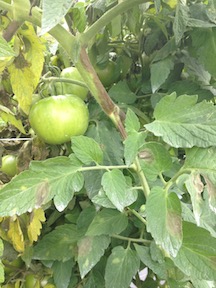An upside of last year’s dry growing season is that we had no reports in New York of late blight, the devastating disease of tomato and potato.
But 2017 is shaping up to be a very different season. We had our first late blight report in Erie County July 10th — and another one from Livingston County on the 13th.

Anyone growing tomatoes or potatoes should be aware of the risk and be alert for the first signs of late blight infection. Learn how to identify late blight — good IPM! — and distinguish it from other diseases with the Distinguishing Late Blight from Other Tomato and Potato Diseases and Identifying and Scouting for Late Blight on Farms videos.
You could also take a sample to your local Cornell Cooperative Extension office for diagnosis. Find your local Extension office at the Cornell Cooperative Extension web site.
Preventing Late Blight
The pathogen that causes late blight in the U.S. overwinters only in living potato tubers. To prevent late blight
- be sure no infected tubers get through the winter alive
- immediately destroy any plants that come up from potatoes that didn’t get harvested last year
- plant certified seed potatoes.
Yet even if you do everything to prevent late blight from getting started in your garden, spores from nearby infected plants can be carried through the air to land on your tomatoes or potatoes.
Plant tomato varieties resistant to late blight to help prevent it from killing your plants — and prevention is a key tenet of IPM. Find a list of late blight resistant varieties in the article Late Blight Management in Tomato with Resistant Varieties.
Some varieties of potato — Elba, Kennebec, Sebago, and Serran among them — have some resistance; they will slow but not prevent late blight infection. If late blight becomes prevalent in your area, fungicides can protect your plants.
But act quickly, applying fungicide before plants are infected. Why? Products available for gardens cannot cure existing infections.
Want to track where late blight has been found? Sign up for text or email alerts on the usablight.org web site.
What to do if you find late blight in your garden
Take immediate action — otherwise you’ll be a source of infection for other gardens and farms. Infected plants release hundreds of thousands of spores that move on the breeze. But first confirm that what you have is late blight and not another tomato or potato disease.
County Cornell Cooperative Extension offices can offer a diagnosis or can submit a sample through the usablight.org web site. Reporting your find on usablight.org and submitting close-up and in-focus photos can sometimes be enough for us confirm a late blight infection.
Though we hate to say it, if the rainy conditions we’ve had so far this season continue, some of us will lose the battle against late blight. If that happens, you can find some suggestions for how to prevent your garden from being a source of infection for the whole neighborhood in the video What to Do if You Find Late Blight in Your Garden.
Good luck! And here’s hoping late blight doesn’t find you this season.
